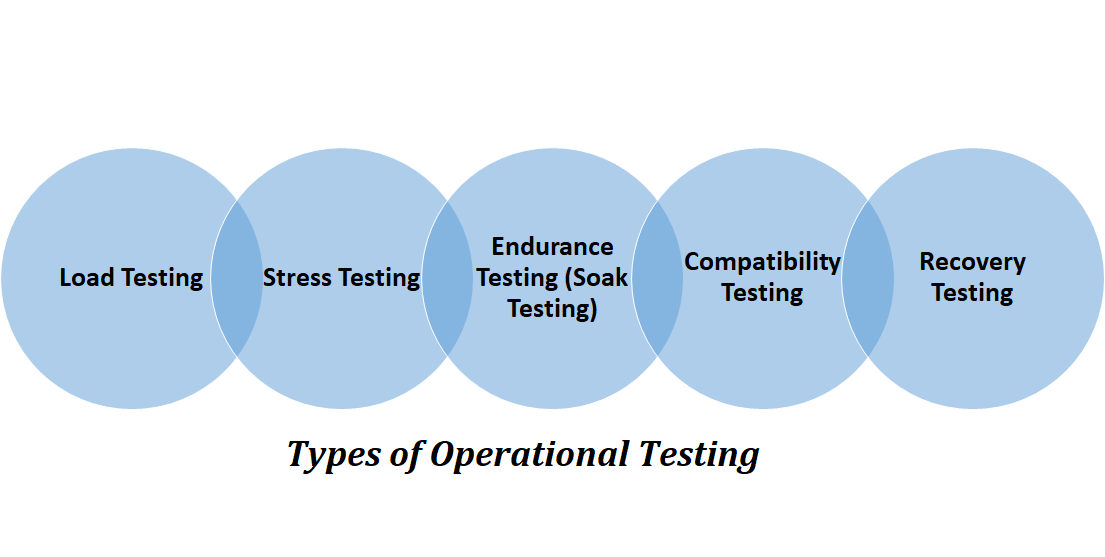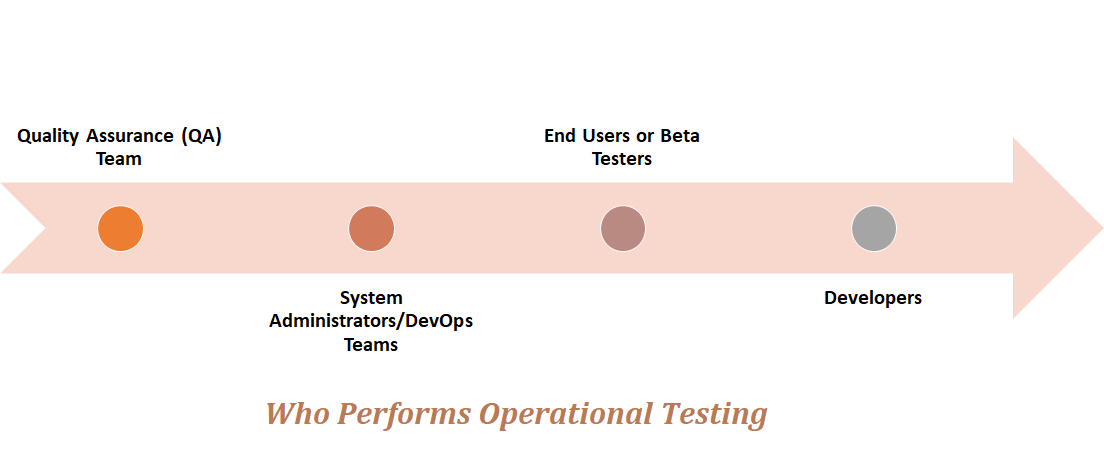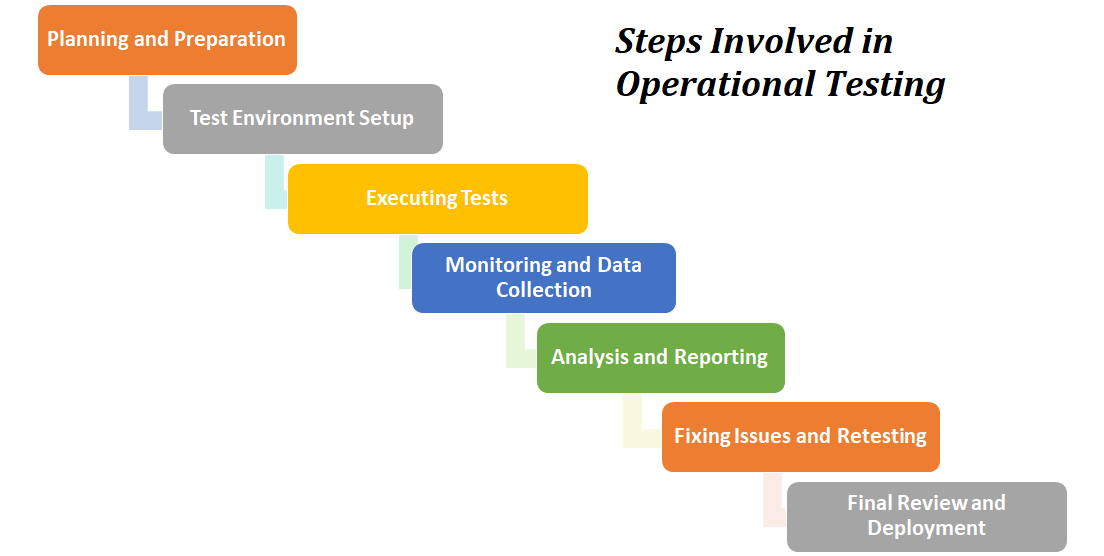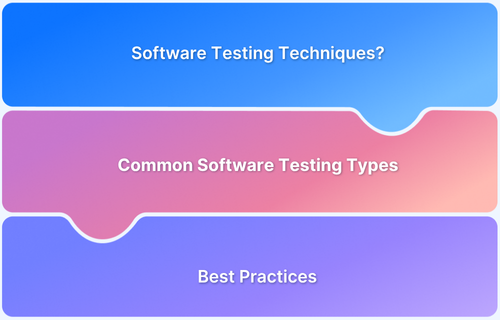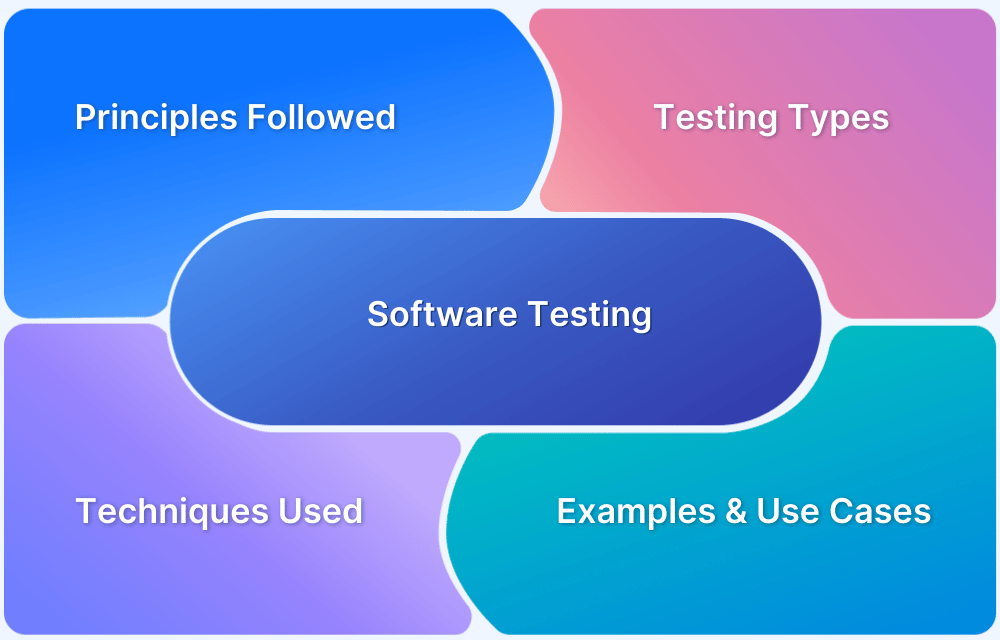Operational testing is the process of ensuring that a system or software functions as expected in a real-world environment. Unlike testing in a controlled setting, this type of testing verifies that the software performs well under actual operational conditions.
The goal is to confirm that all parts of the system work together seamlessly and meet performance standards, even when dealing with real user loads and unpredictable usage patterns.
Overview
What is Operational Testing?
Operational testing ensures software performs as expected in real-world conditions. It evaluates system behavior under actual usage, focusing on reliability, functionality, and compatibility.
Benefits of Operational Testing:
- Validates software performance in real-world scenarios.
- Ensures reliability under different environmental conditions.
- Identifies and mitigates potential operational risks.
- Improves user satisfaction with consistent functionality.
Steps Involved in Operational Testing:
- Define scope, objectives, and performance benchmarks.
- Set up a real-world testing environment.
- Run load, stress, and compatibility tests.
- Monitor system performance and collect data.
- Analyze results to identify issues and areas for improvement.
- Fix issues and retest for stability.
- Conduct final review and prepare for deployment.
This article explores operational testing, why it is important, and how it is applied in real-life scenarios.
What is Operational Testing?
Operational testing analyzes how a software application or system performs in its real-world environment after complete development. It goes beyond just catching bugs i.e., it focuses on assessing whether the system is truly ready for everyday use.
For example, an online food delivery service is preparing for a big update. Operational testing might include simulating real-world scenarios like:
- A sudden spike in orders during a major holiday.
- A server failure to test how quickly the system can recover.
- Testing the app’s performance across different devices and network conditions.
These tests ensure that the platform can handle real-world challenges and continue to provide a smooth user experience under various conditions.
Objectives of Operational Testing
Operational testing ensures a system can handle the challenges it will face once it’s live. Unlike testing in a controlled environment, which often focuses on bugs, operational testing checks how the system performs under real-world conditions, such as heavy user traffic, varying network speeds, or different hardware setups.
The main goals of operational testing are:
- System Performance: Does the system handle the expected workload without slowing down or crashing? This looks at how fast the system responds and how well it scales as more users interact.
- Reliability: Does the system stay stable, even with regular use? This helps identify any weak points that could cause the system to fail unexpectedly or degrade performance.
- Usability: Is the system easy to use and navigate? This focuses on whether the design and features make sense to users and if it’s simple for them to complete tasks.
- Compatibility: Does the system work well across different devices, browsers, and network conditions? Ensuring it works smoothly on all major platforms is key to providing a good user experience.
- Recovery: How quickly can the system recover and continue functioning if something goes wrong? This checks how well the system can handle failures like crashes or network issues and whether it can get back up without major problems.
Benefits of Operational Testing
Operational testing helps ensure that the system will perform reliably after launch, by testing it under conditions that mirror how it will be used in the real world.
Some key benefits include:
- Uncovering Real-World Issues
- Better User Experience
- Increased Reliability
- Reducing Post-Launch Risks
- Ensuring Compliance
Take a look at each benefit explained below.
- Uncovering Real-World Issues: This testing can reveal problems that might not have been obvious earlier. For example, network delays, issues with certain devices, or performance slowdowns when too many users are online at once.
- Better User Experience: It ensures the system is intuitive and easy to use, which can help boost user satisfaction and reduce confusion.
- Increased Reliability: Operational testing helps ensure the system’s reliability, even when things don’t go as planned, by putting it through its paces.
- Reducing Post-Launch Risks: Finding and fixing problems before launch reduces the risk of major failures after the system goes live, saving time and money in the long run.
- Ensuring Compliance: It makes sure the system follows all necessary regulations and industry standards, which can be especially important for areas like data privacy or security.
Types of Operational Testing
There are several types of operational testing, each focusing on different aspects of system performance. The main types include:
- Load Testing: This tests how well the system handles a certain amount of users or transactions at once. For example, it checks whether an e-commerce website can handle thousands of users making purchases at the same time without crashing.
- Stress Testing: This type of testing goes a step further than load testing. It involves pushing the system beyond its normal limits to see how it handles extreme conditions. For example, testing what happens when too many users try to access the system at once or when network bandwidth is limited.
- Endurance Testing (Soak Testing): This ensures the system can handle prolonged periods of usage without issues. It tests how well the system performs over an extended time, checking for problems like memory leaks or slowdowns that may not appear in shorter tests.
- Compatibility Testing: This checks if the system works well across different devices, operating systems, browsers, and network conditions. For example, an app may be tested on both Android and iOS devices to ensure it functions properly on both.
- Recovery Testing: This type of testing checks how well the system recovers after a failure, such as a crash or a power outage. It ensures that the system can return to normal operation quickly and without data loss.
Who Performs Operational Testing
Operational testing is usually performed by a combination of different teams, depending on the size and complexity of the system. Typically, these include:
- Quality Assurance (QA) Team: QA professionals conduct most of the operational tests. They design test cases, execute the tests, and monitor the results to identify any issues.
- System Administrators/DevOps Teams: These teams may conduct tests related to performance and infrastructure. They ensure the system runs smoothly on the servers, handles traffic, and recovers from failures.
- End Users or Beta Testers: In some cases, real users are involved in operational testing, especially during beta testing. These users interact with the system in real-world environments, providing valuable usability, performance, and reliability feedback.
- Developers: Although developers primarily focus on building the system, they may also perform some operational tests, particularly when it comes to performance tuning or investigating specific issues during testing.
Read More: Skills required to become a QA Tester
Steps Involved in Operational Testing
Operational testing involves several steps to ensure the system is fully ready for real-world use. The typical steps include:
- Planning and Preparation: In this phase, the testing team defines the scope, objectives, and requirements for the operational tests. This includes identifying performance benchmarks, expected traffic loads, and any critical system functions that need testing.
- Test Environment Setup: A testing environment mirrors real-world conditions as closely as possible. This may involve setting up hardware, software, and network configurations used in the production environment.
- Executing Tests: Once the environment is set up, the team runs various tests like load testing, stress testing, or compatibility testing. These tests evaluate how the system handles different conditions and workloads.
- Monitoring and Data Collection: During the testing phase, data on how the system performs is collected. This includes metrics like response time, system resource usage (CPU, memory), and errors or failures.
Read More: How to check Website Loading Time
- Analysis and Reporting: After completing the tests, the team analyzes the results to identify any issues. They may look for performance bottlenecks, bugs, or areas where the system is not meeting expectations. A report is created that highlights the findings and suggests solutions or improvements.
- Fixing Issues and Retesting: If any issues are found, the development or operations team works to fix them. Once the problems are addressed, the system is retested to confirm that the fixes work and the system is stable under normal and extreme conditions.
- Final Review and Deployment: After all issues are resolved and the system has passed the operational tests, it is ready for deployment. A final review ensures that everything is in place for the system to perform reliably once it goes live.
Challenges in Operational Testing
Operational testing is crucial for ensuring a system works well under real-world conditions, but it comes with its own challenges. Some of the main challenges include:
- Complexity of Real-World Environments: Unlike controlled test environments, real-world conditions are unpredictable.
Different users may interact with the system in various ways, and external factors such as network traffic, hardware configurations, and even geographic location can affect performance. Simulating these conditions accurately can be difficult. - Scaling Tests: It’s hard to predict exactly how the system will behave when thousands or millions of users are involved.
Load and stress testing must push the system to its limits without harming it, but sometimes, it’s difficult to anticipate how the system will perform under heavy or fluctuating loads. - Time and Resource Intensive: Operational testing requires significant resources and time, especially when simulating real-world usage.
It involves setting up test environments, collecting large amounts of data, and running tests for extended periods. This can be costly and may delay development schedules. - Identifying Edge Cases: Operational testing often uncovers rare or hard-to-reproduce bugs that only happen in specific conditions. These “edge cases” can be challenging to identify and fix, as they don’t always occur during regular use.
Read More: How to find Bugs in Software Testing
- Interdependency of Systems: Many modern systems rely on third-party services, integrations, or APIs. During operational testing, identifying performance bottlenecks or failures that stem from these external systems can be tricky and sometimes out of your control.
- Managing User Experience and Security: Ensuring that the system is both user-friendly and secure under operational testing conditions can be a delicate balance. For example, a system might perform well in terms of speed but fall short in terms of data privacy or security during user interactions.
Functional Testing vs Operational Testing
Functional and operational testing are two important types of testing, but they look at different aspects of a system.
- Functional testing checks whether individual features, such as logging in or completing transactions, work as expected. It ensures that each part of the system performs its specific function correctly.
- Operational testing, on the other hand, focuses on how the system performs under real-world conditions, like handling high traffic, recovering from failures, or dealing with network issues. While functional testing verifies feature functionality, operational testing ensures the system’s overall reliability and performance in practical use.
The comparison is outlined in the table below.
| Aspect | Functional Testing | Operational Testing |
|---|---|---|
| What it tests | Individual features or functions of the system. | How the system performs under real-world conditions. |
| Focus | Ensuring specific features work correctly. | Ensuring the system can handle traffic, recovery, and stress. |
| Environment | Typically done in a controlled test environment. | Simulated real-world conditions (real users, network delays, etc.). |
| Example | Checking if users can log in, submit forms, or make payments. | Testing if the system can support thousands of users or handle a network failure. |
| What it finds | Bugs or errors in specific features. | Performance problems, reliability issues, and system failures. |
| Tools Used | Test scripts, and automated tools for checking functionality. | Performance testing tools, traffic simulators, and real-time monitoring tools. |
Best Practices for Operational Testing
Following best practices is crucial to ensure operational testing is effective. These include:
- Replicating Real-User Conditions: Use real-world data and simulate actual user behavior. This helps uncover performance issues that might not appear in a controlled environment.
- Comprehensive Coverage: Test across various environments, different devices, browsers, operating systems, and network conditions to ensure compatibility and performance.
- Stress and Load Testing: Test how the system behaves under extreme conditions (heavy traffic, limited resources) to identify weaknesses and performance bottlenecks.
- Continuous Monitoring: Track system performance throughout the test to gather data on response times, errors, and resource usage.
- Early and Frequent Testing: Start testing early in the development cycle and perform tests frequently to catch issues before they escalate.
Why run Operational Tests on Real Devices?
Running operational tests on real devices is critical to simulate how end-users will actually interact with the system. Testing tools like BrowserStack Live and Automate offer powerful solutions for testing on real devices in real time:
- BrowserStack Live performs web application testing on real browsers and devices, ensuring your users experience the site as intended across all platforms.
- BrowserStack Automate enables automated testing across a wide range of real devices and browsers, helping you scale your testing without compromising quality. It ensures consistent performance and reliability, even when multiple users are interacting with the system simultaneously.
Testing on real devices ensures you account for real-world variability and edge cases that may not be visible in emulators or simulators, making your system more robust and user-ready.
Conclusion
Operational testing is essential for ensuring that a system can handle real-world demands and provide a seamless user experience. By following best practices, testing on real devices, and using tools like BrowserStack Live and Automate, teams can identify and address performance issues early.
Ultimately, operational testing ensures that individual features work and guarantees that the system as a whole performs reliably and efficiently under real-world conditions.


